American Sabbatical 025: 9/30/96
Yellowstone
9/30.. Yellowstone.
The shaking of Festiva as she galloped down that mountain road was right in sync with
our chills. But seeing the Granite River tumble along its rocky
bed below us, and watching the sunrise behind the morning-etched
heights made our discomforts easy to forget. The high alpine air
invigorates you like hood scoops on a 4-barrel carb, then blows
you out the tailpipe. You feel you can run at high revs all day,
and you’re exhausted by noon. So we spun rubber into Jackson Hole,
ready to swallow Yellowstone whole for breakfast. Along the way
we crossed and recrossed the upper Snake River, infamous in its
lower regions as the nastiest road to the Columbia, but just a
young mountain serpent up here.
We knew we’d reached civilization when we hit Jackson. There was
a bookstore AND a healthfood store AND yuppies in birkenstocks
(and just a trace of local condescension). We stocked up on veggieburger,
ate spinach croissants, drank exotic tea, and perused the lit.
A clutch of high country titles I’d like to nose through.. Ruxton’s
autobiography, some unfamiliar Stegner, a book by Dobie on coyotes..
but our purses are thin and lightsout is early anyhow. I did notice
that most of the good stuff was published by U. of Oklahoma, so
I’ll stalk their catalog in fatter times.
|
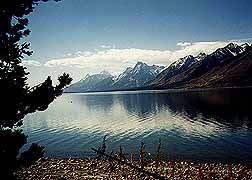
Teton Lakes
|
One book I keep searching for just doesn’t seem to exist: a layman’s
fieldguide to American landforms. The geology texts are either
too technical, too localized, or both. And they don’t really deal
with topography. Rocks, minerals, tectonics, geologic epochs,
all that stuff is fascinating, but I want to know what that mountain
is doing there and how it relates to the territory around it.
Geology is like so many other sciences, the practitioners think
you have to study the subject for four years before you can talk
about the obvious. Imagine if you had to study automotive engineering
before you could change your sparkplugs? The outsides of geology
are right in our faces, but there doesn’t seem to be a hands-on
text for travelers? The “Roadside Geology of...” series is too
deep and it would cost a fortune to have the whole series. John
McPhee’s books on geology are the best lay intro to geology that
I’ve read, but they don’t cover most of the country, and are not
accessible by random access. McPhee's notion of telling a story
about crossing the country with geologists, with asides to the
Precambrian, is neat. Reading McPhee you find layers of time unpeeling,
and the view down the geologic tunnel is spectacular, but once
you’ve finished you still can’t remember which is what and where.
The story was too captivating. So where is the Peterson’s Guide
to Landforms?
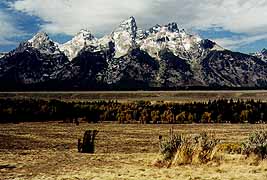
Postcard View
|
We were about to need it. We were on the doorstep of Yellowstone
Park, where Mother Earth exposes herself to ogling lines of Japanese
and American tourists, and we didn’t have a guide. We joined the
cue. Between Jackson and Yellowstone the highway parallels the
most photographed mountain view in America: the Grand Tetons.
This is placemat and motel-art country, and I just figured out
why it has that timeless quality reserved for National icons.
Those peaks have been frozen in so many photographs their morphic
resonance is in a standing wave. They’ll be stopped dead in so
many 20th century photo albums they’ll never escape. Peggy says
they scream in the 60minute photo joints around here every time
a Teton shot appears. Of course we stopped and took pictures. |
Driving in Yellowstone is sporting.. rubberneck and ram’em the
local towboys chant. It was hairy on October 1. I can’t imagine
what high season might be like. As experienced lawn ornament connoisseurs
we are well practiced in the squeal and snap-it, however, and
escaped uncrumpled. Yellowstone is so big that the ritual pace
of other national sites doesn’t apply. You can get up to 50mph
between scenic episodes, making the Winnebagos wilder and the
footwork fancier.
| In some ways this is the naked heart of North America. It straddles
the continental divide and runs up to the 45th parallel of latitude..
halfway to the pole from the equator. And it may be emblematic
of our present state: over the hill, but only halfway there. Much
of Yellowstone was burned over by the fire of 1988, and you drive
for miles through scorched earth, with the black spears of burned
lodgepole pines jabbing the sky all around. We come to see nature
in the raw, and she’s blistered. It’s still a spectacle. At Grant
City we stopped to mail some letters, and the park rangers were
burning a pile of lodgepoles. The acrid smoke clung to us for
miles. Just a memento of nature at play. |
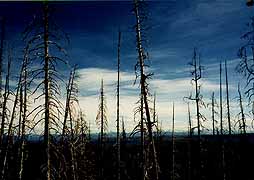
Fire View
|
As we drove up onto the caldera (the rim of the volcano that made
Yellowstone) another familiar aroma embraced us. That old sulfur
and brimstone. We were headed for Old Faithful, and she dances
in a blasted landscape. She’s also surrounded by the biggest parking
lot west of the Mall of America. Festiva was lost in all that
asphalt acreage.
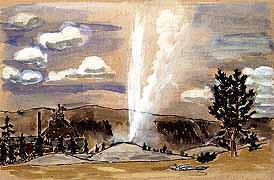
Old Faithful
(Bryce)
|
We were clever, though. We took our drawing supplies, because
we knew we would have to wait for the BIG MOMENT. We did wonder
why everyone else was gathering on benches on the side opposite
to us. But we were smug in the knowledge that we had the artist’s
view, and didn’t behave like lemmings. So when she whooshed her
spritz we got what we deserved. We were downwind. I can show you
the watercolors.. sort of.
|
Is it ridiculous to try and describe what hundreds have described
before? Are there tongue ruts in the road to perdition? Are we
fated to repeat worn cliches while up to our necks in boiling
lava? Let’s try this: The Caldera of Yellowstone is as full of
spurting and fuming as a Republican politician, but smells a little
better. The reeking pools of boiling water and the caked basins
of mineral salts, seen through the fire-ravaged trees, with lines
of squeaky-clean tourists armed with camcorders parading through
the mist, is a pretty good image of a Gingriched landscape. No?
| By the time we left the geological war zone our revs were running
down. But we had miles to go before ... (we’d booked into the
Super8 north of the park.. on the first day of off season rates!).
The north end of the park woke us right up. The West is full of
discontinuities. You drive out of one landscape into another,
radically different, in the blink of an eye. Out of the dense
verticality of lodgepole forests in steep mountains we were suddenly
in rolling high prairie alongside the Yellowstone River, with
herds of buffalo grazing, for all the world like in a Catlin or
a Miller. |
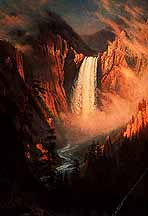
Moran
|
Then POW there was the Grand Canyon of the Yellowstone, where
you could stand in Moran’s footprints and look down into a famous
landscape. He did get it just right. That lurid yellow. Those
crazy pinks and oranges. The whole dizzy smear. And it didn’t
look like an old painting at all. The giddy heights were too vertiginous
to get nostalgic over. In the parking lot I walked up on a big
raven. Amazing. Do the critters know that people with cameras
are only half there?
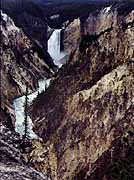
Moranscape
|
Out of that plunging declivity we drove into mountain meadows
with luminous yellow aspens, orange and bronze grasses and small
shrubs, and the dusty sage. Then into pine woods where the road
snaked between looming hills again. On the hillsides and along
the river, elk were browsing in the low-angled light.
Plumes of fragrant steam rose up on either hand and we’d pass
through the broken rubble of volcanic aftermath and tectonic excess.
Holy Buffalo. The north gate of Yellowstone features Mammoth Hot
Springs, a whole hanging garden of sulfurous delight looking down
on a hospital spa where elk wander in the street, followed by
Kodaclicking tourists. Us, too...us, too. And then it’s a switchback
descent out of the magic kingdom into Gardiner. And a room at
the inn. |
(Memo #25)
|
Oct. 2 - Yellowstone Wilds
Who? explorers, naturalists, artists, tourists
What? first national park with many geographic marvels (Old Faithful,
Grand Canyon of the Rockies, mammoth hot springs)
Where? northwestern Wyoming
When? created 1872
How? created by geological forces over eons, made accessible in
20th century by extensive tourist infrastructure
Topics: national parks, endangered species, wild v. domesticated
Questions : How do you give people access to the wilderness? How
can you provide wildlife protection and promote tourism? |
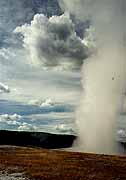
Old Faithful
|
Yellowstone overwhelms. It has every conceivable kind of landscape
- high mountains, blasted plains, lakes, meadows, gorges and waterfalls,
heath and woods. The changes of topography are breathtaking -
at the northern entrance you drop from a high mountain plateau
to a river valley in a few miles of steep, twisted road. Part
of the park was hit by fires in 1988 and there are huge areas
of standing black trees. There are thermal areas everywhere, steam
blithely puffing from beaches and hot springs and geyser holes.
The central area of the park is the remains of an erupted volcano.
It is very beautiful.
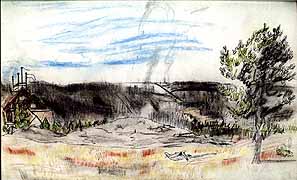
Old Faithful
(Peggy)
|
From the earliest explorers, Native Americans and Anglos have
recognized Yellowstone’s power and worked to protest it and share
it. Thomas Moran’s incredible oils of Yellowstone were part of
a successful campaign to create a national park to “save” the
place for the future. The park has been consciously structured
and modernized for tourists and VIEWING. |
The roads put visitors within easy walking distance of all the
key sights - Old Faithful, the Grand Canyon of the Rockies, the
lake. There is a scenic turnout for vehicles at every great view.
In fact many visitors see the park through their cameras. Dangling
from the wrist, cameras are held up at every “sight” and Yellowstone
provides thousands. At Old Faithful there are rows of viewing
benches on a huge wooden deck that half circles the geyser at
a distance. The information booths have eruption times posted.
Every overlook has carefully constructed paths and platforms and
benches.
|
Mammoth Hot Spring is an incredible area where minerals have built
up a series of terraced pools that spill down a hillside to a
small plateau where a clinic was established for those taking
the water. The pools still hiss and heave and flow. You follow
long boardwalks and stairs to skirt the springs. Frequent signs
warn that the ground is unstable and that tourists have been scalded
to death. Stay on boardwalks.
(Why do I trust the ground under the boardwalk?)
|
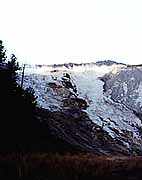
Mammoth Hot Springs
|
The park has a huge number of tourist accommodations, but within
very constricted areas, so there's an odd mix of wilderness areas
and motel center (ten miles of gorgeous woods and then an inn
site with 200 rooms!). Over half the motels/hotels/inns/cabins/campsites
were closed when we arrived. It was off season and still there
was traffic. With so many people driving so many types of vehicles
- buses and huge RVs and jeeps and vans and cars - on the twisting
two lane roads and switchbacks with thousand foot drops, there
was constant tension for the driver. It was scary to contemplate
high season - it must be bumper to bumper. I’m not sure how much
the drivers get to “enjoy”.
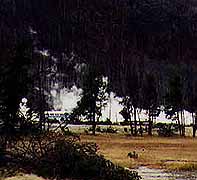
Geyser Bus
|
The park must also provide services for visitors; there are medical
clinics, restaurants, gift shops, gas stations, auto mechanics.
There is a huge staff of service providers and maintenance staff
who also need housing and transportation. There is garbage from
everyone - candy wrappers and film cartons and plastic bags. So
there are thousands of specially constructed garbage cans.
(We heard that Yosemite had gotten so crowded that you can no
longer drive through that park. You leave your car outside and
are ferried around on special park service trolleys.) |
How do you protect wilderness? Do you allow fires to burn as they
did in the past or do you have planned burns ? What in fact does
the term wilderness mean if a million people a year are driving
through it? If it means planned and limited construction then
we’ve been successful at Yellowstone. But if wilderness means
an area away from man and his works, then Yellowstone may not
fit the category. You CAN hike into “back county” having registered
and prepared and there is a list of rules to follow, for example,
pack out all your garbage. Again a logical campaign to preserve
the wilderness for the masses.
| One task is to protect and cultivate the flora - and you must
prevent the tourists from taking one flower, one rock, one pine
cone. Silly? Multiple each by the millions who come through each
year. I found myself constantly aware of the dozens of footprints
across every bare spot, the legions of cigarette butts at any
stop. |
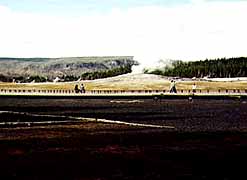
Geyser Parking
|
There is also the wildlife to protect. When you enter you are
handed brochures and broadsides about the park and its animals.
Every text warns you not to get too close to the animals. Definitely
don’t feed animals. One text said that if you feed an animal,
you kill it. Why? It will begin to expect handouts and will start
harassing visitors and will have to be euthanized. Remember, we
were constantly reminded, there are large and dangerous animals.
A bright yellow sheet told us that tourists had been killed by
buffalo goring this past summer.
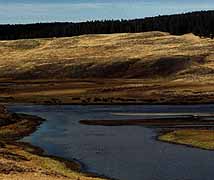
Bison Valley
|
Every five to ten minutes as we drove we would come upon a few
parked cars with people training cameras and binoculars on an
animal or animals. In fact the way to find the wildlife in Yellowstone
is to watch for stopped cars. In spite of all the warnings, people
show very little sense. We saw tourists advancing on herds of
buffalo and heavily antlered elk, even with small yappy dogs alongside!
People may think the camera makes them immune. |
There is so much wildlife so close that you definitely become
blase - oh, there’s another elk (on a motel lawn, going through
downtown Gardiner just outside the park, lying on the lawn at
a thermal spring). It’s bizarre to get an ice cream and go out
to a lawn and suddenly realize you have to check for elk dung
before you sit!!!! And is an animal wild if it casually allows
families and RVs to approach to within twenty feet?
The very access provided to tourists - the safe approaches and
views - masks the truths. The wilderness is dangerous and powerful.
Yellowstone was formed violently. Thermal eruptions and fires
and earthquakes and buffalo attacks still occur. I got chills
at many spots where we stopped, thinking that the scene could
be exploded anytime. Why was everyone placidly taking pictures?
Still there are magic moments. We did see a bighorned sheep way
up on a mountain outlined against the sky.
|
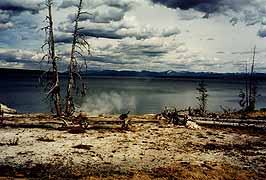
Steaming Beach
|
When you leave Yellowstone by the north gate you descend a mountain
in a series of tight switchbacks that bring you down very fast.
Suddenly you’re out of the park in the town of Gardiner. You look
back up and see a blank mountain face. I felt like a child in
a fairy tale - through the wardrobe, over the mountain lies the
magic. If you can get up, you can recapture it.
10/2.. A DAY OFF.
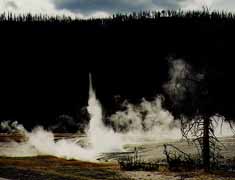
Woosh
|
When we woke up in Gardiner neither of us had the oomph to pack up Festiva and ride. We had
been aiming for a pitstop in Missoula at a friend’s sister’s house,
but the 45th parallel was where we all fell down. We had puting
to do, there was a hot pool in the motel, the folks were friendly
and helpful, our supper of fresh trout last night had been perfect,
it was the off season, and we were pooched. Peggy actually found
us fresh salad for lunch, what more could you hope for? |
| After we caught up on our electronic correspondence, we decided
that a long walk in the magic kingdom was in order, so we drove
through the stone triumphal arch that is the north gate to Yellowstone
Park, and parked beside the river that flows below the caldera.
The Gardiner River. At the beginning of the path we were warned
that 20,000 people use it every year, and not to disturb the environment,
no nude bathing, no, no, no. That warm federal presence. Here
was an unmapped walk on the outskirts of the Park, and it was
still at risk from over-use. We had tried to eyeball signs of
the the emigrants along the Oregon trail, but couldn’t distinguish
pickup tracks from wagonruts, and here were the grooves of contemporary
pilgrims searching for renewal. We’d simply been looking in the
wrong place for the marks of great migrations. |
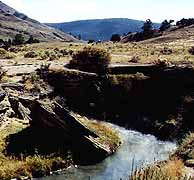
Boiling River
|
The river path was paved with cinders, and well-trodden in, but
the coruscating waters, the sear hills, the massive old junipers
and sage bushes, the crystal light and the etched hills, didn’t
seem to mind our passing. We hadn’t realized there was a boiling
river pouring out of the broken hill beside us, making a pocket
spa in the Gardiner about 1/4 mile upstream. There were young
pilgrims taking the waters, and flycasters doing their ritual
thing with handmade fetishes up and down stream.
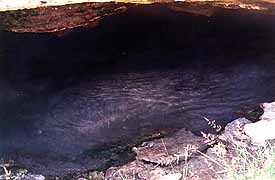
Brain of the Mountains
|
We walked on, Peggy carefully keeping to high and solid ground,
Bryce poking here and there, trying not to step on the vegetation.
The water in Boiling River was, indeed, boiling to the touch.
There were sauna caves where you came out smelling like an underground
nightmare. Then there was a boiling pool in which the sediments
had left colored patterns on a mound of rock just below the surface.
It looked like to top of a huge exposed brain, steaming and stinking
under a cindery white outcrop: the great brain of the mountains.
|
Farther along the river path we encountered a large snakeskin,
which we left lie in respect for the park...and because Peggy
said, “Don’t you dare.” Eventually we stopped on a slight bluff
overlooking a couple of fly-casters to sketch and soak up the
place. Or maybe it was the place that soaked us up. We drank half
a quart of water, and turned back. It was time for me to act as
guide of the mountains. I led Peggy by the hand to the brain pool,
then proposed the sauna cave. Peggy is claustrophobic, so her
quiet assent was remarkable. She even led the way down toward
the crack. I had to grab her to keep her from stepping on the
big snake sliding through the fumes. It didn’t rattle, just slipped
down into the cracks. Symbol of the earth spirit taking our breath
away.
| Subdued, we repassed the water celebrants, and came face to antler
with a herd of elk standing in the cooler waters, and browsing
in the shade of the junipers. The nature stuff comes too fast
and furious in this place. You begin to wonder about “wild” animals
that are so tame you have to fence your flowers in town. The Disneyland
atmosphere at Yellowstone muddles that separation between nature
and culture which enables respect. The magic of manicured encounters
is movie magic, and the fastforward display at Yellowstone is
like channel surfing. Oh, there’s another elk. There are pullovers
for every encounter. See the bison, here. Film, gas, and ice cream,
with mud geysers. Stop here for photo op. |
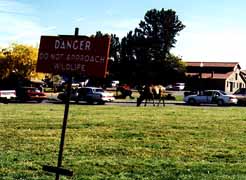
Elk Parking
|
On the one hand we have returned Nature to the Holy, which completes
a circle with the Deism of Jefferson. Yet we haven’t taken the
crown of creation from man, just changed his role to park ranger,
and tourist.
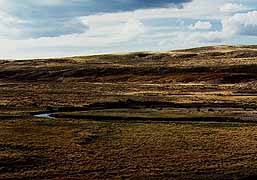
Bison in the bend
|
Our encounters with bison in the badlands seemed almost a meeting
of equals. In this park the animals seem there for show. The fact
that there have been a number of gorings (one recent fatality)
indicates that there is little sense of wild clinging to these
park performers. Now they are reintroducing wolves to Yellowstone,
and handing out literature about how wolves are good for the ecology..
and the spirit of the place. I’m unconvinced that encounters with
wolves can make a wilderness out of the Mall Of The Wild. Yellowstone
IS a magic kingdom, as travelers from Colter on down have proclaimed,
but are we loving Nature to death here? (John Colter left the
Lewis and Clark party on their return trip, at the Mandan villages,
and retraced their steps to the Yellowstone, which he ascended
to trap beaver, and became the first American to report on this
wonderland.) |
| So we remounted Festiva and took one last canter up onto the caldera
to walk around the Mammoth Springs. There is a globular pillar
standing at the foot of the mineral terraces topped with steaming
turquoise pools. Descending from the heights, the pillar looks
to be surmounted by a squat samurai . Nature having her little
joke with the tourists. |
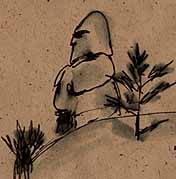
Bryce's Samurai
|
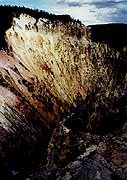
Yellow Stones
|
We spoke with a ranger, a retired Ag. Department administrator
from DC, who had answers for all our questions. For example: “Yellowstone”
was an Indian name in translation, which is how Lewis and Clark
could identify it at its mouth by a name describing its headwaters..
by word of mouth. And that the yellow isn’t minerals but strains
of bacteria. Bacteria which thrive above the sterilization point,
and which might be found on the hot planets to sunward. He referenced
the monographs. |
And here we are back in the circular argument. Scientists have
their cool reverence for nature, small n, and nature parks are
their special domain for research and regulation. Well.. a snake
in all their saunas. I’m not ready to grow out dredlocks and skinnydip
in the Boiling River chanting mantras, but I distrust too much
rationality, too. The earth is telling us something in this blasted
circle at the top of America, but we may be too busy translating
it into specialized babble to hear. Like in Hollywood we’ve glorified
the charge of a powerful experience without honoring its mystery.
Look there’s another buffalo.
| We stopped for ice cream with elk in Mammoth. Then made our last
descent from the Park. On the final switchbacks cars were pulled
off whichaway, with tripodded long-lensers all aiming uphill at
the surrounding cliffs. And, YES. On the canyon rim, silhouetted
against that pure western blue, was a bighorn sheep. Well out
of petting distance, still king of his own realm. Maybe he’s a
reintroduced critter, but he still dances on the edge of magic.
What does the brain of the mountains think? Who knows what the
Yellowstones tell us. Don’t drink the water. |
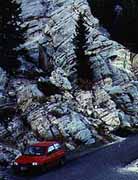
Tourist stop
|




















